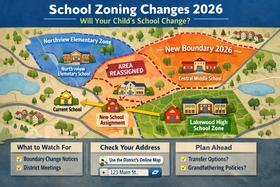Dual-enrollment programs have become a popular way for high school students to explore the world of college curricula prior to their high school graduation. These programs typically exist between high schools and neighboring community colleges, offering students the chance to earn college credits – often tuition-free - while still in high school. The rising popularity of dual-enrollment has led many students and their parents to explore the potential benefits of such a program in their own academic endeavors. Check out these benefits of a dual-enrollment program – as well as some of the possible reasons why dual-enrollment may not be the best choice for you.
What is Dual-Enrollment?
According to the website for Columbia State Community College, dual-enrollment is a program that provides the opportunity for qualifying juniors and seniors in high school to take college-level courses. The courses may be offered on the community college campus or right at the high school. Specific laws involving eligibility, tuition rates, and earned credit opportunities vary from state to state.
In many cases, there is no tuition charge for high school students participating in the dual-enrollment program – a huge boon to those concerned about the cost of higher education. Other programs might involve a tuition fee, although it is often highly discounted from what students will pay after graduating from high school. High schools are generally responsible for overseeing dual enrollment programs.
This video explores the suitability of dual enrollment.
More Schools Offering Option
The Journal recently reported that more high schools are offering dual-enrollment options than ever before. The publication provided results of a survey conducted by The National Center for Education Statistics, which showed 82 percent of high schools offered some sort of dual-enrollment program during the 2010-2011 school year. That number is a distinct increase from the 71 percent offering similar programs during the 2002-2003 school year.
Most of those classes were offered on high school campuses, although a small number were also provided at colleges. Approximately 45 percent of students participating in academic programs paid tuition, while another 46 percent paid fees. Fewer students paid tuition or fees in technical and vocational dual-enrollment programs because it was more common for school districts to pick up the tab for these programs.
Potential Benefits of the Program
There are many potential benefits to a dual-enrollment program, according to the website for Northwest Iowa Community College. These benefits include:
- Less time required after high school to finish a college degree
- Provides students with a head start on the college experience
- Dual-enrollment classes often save students money on tuition
- Students may enjoy access to the college library and resources
- Grades earned become part of the student’s permanent transcript
- Students may be able to transfer credits earned to a four-year school
- Classes may offer a lower ratio of students to instructors
- Students may explore fields of study that help them choose a major later
- Students may choose from classes not currently available at their high school
Dual-enrollment gives students a taste of college coursework while they are still enjoying the safe confines of the high school environment. At the same time, students earn credits that will apply toward a two-year degree at the school, or even toward a four-year degree, if the credits transfer fully to the four-year school of choice.
Who Enjoys the Benefits?
When dual-enrollment programs first started, the primary recipients of the benefits were high-achieving students, hand-picked by high school faculty, and administrators for the programs. However, Inside Higher Ed reported a number of years ago that studies show these programs offer similar benefits to students who may not be as academically inclined. Dual-enrollment programs have been linked to higher high school graduation rates and increase the likelihood that students will enroll in an institution of higher education.
In addition, students who completed dual-enrollment programs in high school tended to have higher cumulative GPAs during their first three years in college. These benefits held true both for the high-achieving students and students from other subsets. Advantages were also seen in the population of male and low-income students, two subsets that often struggle academically in high school and beyond. The study urged states to continue expanding dual-enrollment opportunities to students across the board, particularly those that do not typically see themselves as college-bound.
This video offers one student's opinion of dual enrollment.
Reasons to Reconsider Dual-Enrollment
While dual-enrollment offers a host of benefits to many high school students across the country, there are some reasons why parents and students might want to reconsider this option. According to Study Point, some of those reasons might include:
- Students who are able to take a wide range of Advanced Placement (AP) courses at their current high school may be able to earn just as many college credits through these programs. In some cases, AP courses might actually be more rigorous than the college equivalents.
- If students are involved in extracurricular activities to build their college resumes, they should think twice about dual-enrollment courses that would interfere with those activities. Colleges look at both academics and extracurricular activities when evaluating students for admission.
- If a student is unsure of his ability to keep up with a college-level course at this particular time, dual-enrollment may not be the best option. Grades earned in dual-enrollment courses go on the permanent transcript and could interfere with admission to college if they are low.
Dual-enrollment is a viable option for many high school students looking ahead to college today. If you or your student is interested in dual-enrollment opportunities, contact the counseling office at your high school to find out what options are currently available.
Questions? Contact us on Facebook @publicschoolreview.












